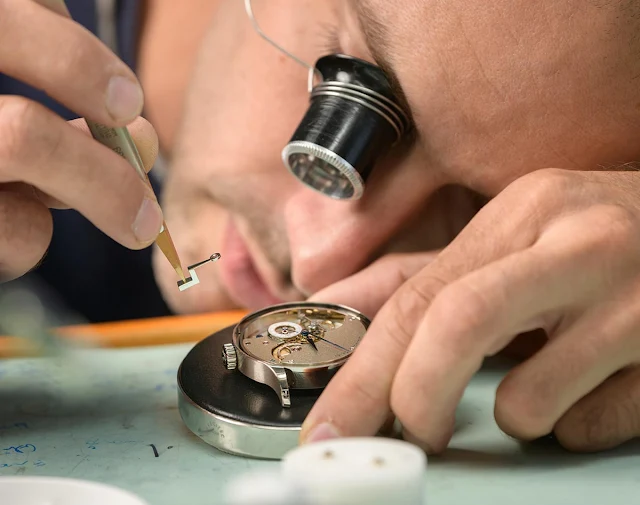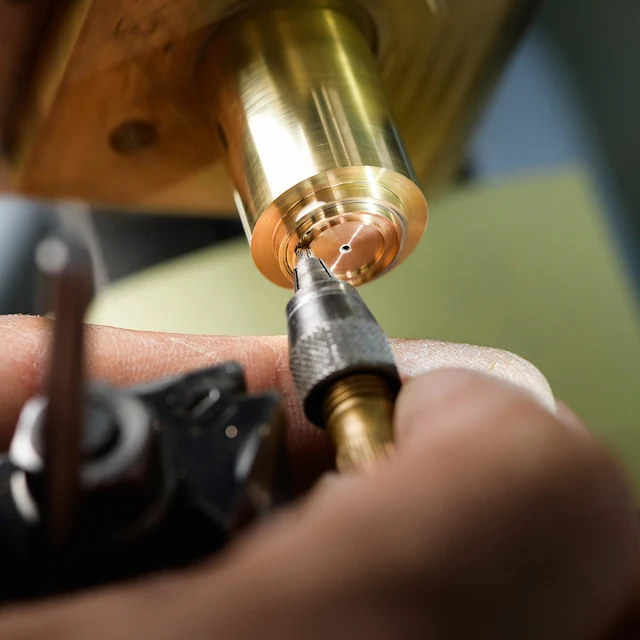With the new Hand Made 1, Greubel Forsey has found a way to further raise the bar and surprise us once again. 95% of this timepiece – including the hairspring – is made using only hand-operated tools. Greubel Forsey will produce only two or three Hand Made 1 timepieces per year. Considering that each piece will be truly unique by virtue of it being made by hand, a price has not been set at the moment.
Greubel Forsey has got us used to exceptional timepieces characterized by great inventiveness and outstanding quality. Nonetheless, with the new Hand Made 1, the Swiss brand has found a way to further raise the bar and surprise us once again.
95% of this timepiece – including the hairspring – is made using only hand-operated tools. Just imagine that one single timepiece requires an extraordinary 6,000 hours work (equal to three years man-hours).
With the new Hand Made 1, Greubel Forsey takes traditional watchmaking to a new level.
With industrialisation, excellence in hand craftsmanship has virtually disappeared. Watch components that had to be made one by one, developing requiring very specific skills and using hand-operated tools, are produced today using highly automated machinery and technologies.
In line with the "Le Garde Temps - Naissance d'une Montre", a 2015 project whose main goal was recording and preserving for posterity traditional watchmaking techniques, Robert Greubel and Stephen Forsey are willing to take these ancient skills and know-how to a previously unattained level of excellence and precision, furthering them in the same spirit of constant improvement that has always guided their career.
The goal is to resurrect the ancestral art of hand craftsmanship and reinforce it with standards of workmanship and precision rivalling even modern production equipment. To fulfil this exceptional challenge and reach micron-scale accuracy using ancestral tools, the artisans must obtain a precision that such traditional machines themselves cannot easily offer.
A project of this scale could not be simply incorporated within existing structures or even to just one or two watchmakers. To complete this feat, Greubel Forsey had to build a team of the most skilled craftsmen in each field, principally from its workshops, as well as several external talents.
The Hand Made 1 – an hours/minutes/seconds timepiece with a tourbillon - is the result of this unprecedented watchmaking approach. An entirely handmade timepiece: from the movement to the case, to the leather strap, the dial and the hands – the only exceptions being the sapphire crystals, the case gaskets, the spring-bars, the jewels, and the mainspring.
Comprised of 272 movement components and 36 case parts, the Hand Made 1 demanded a total overhaul of the creative process, involving the people who would make and decorate each component from the very beginning. This project’s daring was only matched by the creativity and inventiveness required to find new technical solutions. The timepiece’s relatively modest dimensions (43.5 mm in diameter and 13.5 mm thick) further heightened the difficulty of this task.
Some parts of the movement were redesigned in order to simplify them. Meanwhile for other mechanisms such as the tourbillon, the number of components had to be increased to allow each part to be made by hand.
It took almost 35 times longer to make the complete tourbillon cage than for a standard high-end tourbillon.
When just a dozen operations on an automatic lathe effortlessly yield some 500 screws, a single screw, as small as it may be, requires up to 12 individual operations taking up to 8 hours to make just one. Finally to hand make one wheel of the Hand Made 1 takes 600 times longer than that of a high-end industrial wheel.
The creation process begins with the regulating organ, entirely produced by hand in Greubel Forsey’s workshops, including the balance spring, fashioned from an alloy in the Atelier. The balance spring is then rolled in a hand operated rolling mill (without computer assistance). The balance wheel is also entirely hand-made with an extraordinary standard of precision and finish. The escape wheel, with its 20 individually-cut teeth, each with four surfaces that are later ground, is a true tour de force. The machining and finishes of the escape lever alone require a month and a half of work.
The Hand Made 1 is immediately recognizable as a Greubel Forsey timepiece. The open dial stands out with its hand-enamelled chapter rings, paired with elegant, finely shaped flame-blued steel hands. The inscription HAND MADE replaces the usual SWISS MADE.
All the movement’s components are hand finished true to the finest watchmaking tradition, including the bridges with their polished inner and outer vertical flanks, the unique “Gratté” mainplate, and the wheels with hand polished bevels top and bottom (40 sharp internal angles for a five-spoke wheel).
The 18k white gold case is also, handmade, thanks to a pantograph mechanical lathe fitted with turning tools, before being meticulously satin-finished on the sides and polished on the upper surfaces.
Greubel Forsey will produce only two or three Hand Made 1 timepieces per year. Considering that each piece will be truly unique by virtue of it being made by hand, a price has not been set at the moment. greubelforsey.com
95% of this timepiece – including the hairspring – is made using only hand-operated tools. Just imagine that one single timepiece requires an extraordinary 6,000 hours work (equal to three years man-hours).
With the new Hand Made 1, Greubel Forsey takes traditional watchmaking to a new level.
With industrialisation, excellence in hand craftsmanship has virtually disappeared. Watch components that had to be made one by one, developing requiring very specific skills and using hand-operated tools, are produced today using highly automated machinery and technologies.
In line with the "Le Garde Temps - Naissance d'une Montre", a 2015 project whose main goal was recording and preserving for posterity traditional watchmaking techniques, Robert Greubel and Stephen Forsey are willing to take these ancient skills and know-how to a previously unattained level of excellence and precision, furthering them in the same spirit of constant improvement that has always guided their career.
The goal is to resurrect the ancestral art of hand craftsmanship and reinforce it with standards of workmanship and precision rivalling even modern production equipment. To fulfil this exceptional challenge and reach micron-scale accuracy using ancestral tools, the artisans must obtain a precision that such traditional machines themselves cannot easily offer.
A project of this scale could not be simply incorporated within existing structures or even to just one or two watchmakers. To complete this feat, Greubel Forsey had to build a team of the most skilled craftsmen in each field, principally from its workshops, as well as several external talents.
The Hand Made 1 – an hours/minutes/seconds timepiece with a tourbillon - is the result of this unprecedented watchmaking approach. An entirely handmade timepiece: from the movement to the case, to the leather strap, the dial and the hands – the only exceptions being the sapphire crystals, the case gaskets, the spring-bars, the jewels, and the mainspring.
Comprised of 272 movement components and 36 case parts, the Hand Made 1 demanded a total overhaul of the creative process, involving the people who would make and decorate each component from the very beginning. This project’s daring was only matched by the creativity and inventiveness required to find new technical solutions. The timepiece’s relatively modest dimensions (43.5 mm in diameter and 13.5 mm thick) further heightened the difficulty of this task.
Some parts of the movement were redesigned in order to simplify them. Meanwhile for other mechanisms such as the tourbillon, the number of components had to be increased to allow each part to be made by hand.
It took almost 35 times longer to make the complete tourbillon cage than for a standard high-end tourbillon.
When just a dozen operations on an automatic lathe effortlessly yield some 500 screws, a single screw, as small as it may be, requires up to 12 individual operations taking up to 8 hours to make just one. Finally to hand make one wheel of the Hand Made 1 takes 600 times longer than that of a high-end industrial wheel.
The creation process begins with the regulating organ, entirely produced by hand in Greubel Forsey’s workshops, including the balance spring, fashioned from an alloy in the Atelier. The balance spring is then rolled in a hand operated rolling mill (without computer assistance). The balance wheel is also entirely hand-made with an extraordinary standard of precision and finish. The escape wheel, with its 20 individually-cut teeth, each with four surfaces that are later ground, is a true tour de force. The machining and finishes of the escape lever alone require a month and a half of work.
The Hand Made 1 is immediately recognizable as a Greubel Forsey timepiece. The open dial stands out with its hand-enamelled chapter rings, paired with elegant, finely shaped flame-blued steel hands. The inscription HAND MADE replaces the usual SWISS MADE.
All the movement’s components are hand finished true to the finest watchmaking tradition, including the bridges with their polished inner and outer vertical flanks, the unique “Gratté” mainplate, and the wheels with hand polished bevels top and bottom (40 sharp internal angles for a five-spoke wheel).
The 18k white gold case is also, handmade, thanks to a pantograph mechanical lathe fitted with turning tools, before being meticulously satin-finished on the sides and polished on the upper surfaces.
Greubel Forsey will produce only two or three Hand Made 1 timepieces per year. Considering that each piece will be truly unique by virtue of it being made by hand, a price has not been set at the moment. greubelforsey.com





















COMMENTS